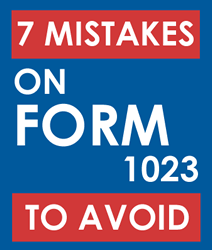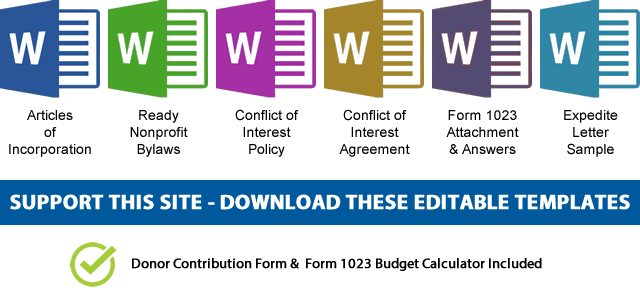7 IRS Mistakes That Get Your Form 1023 Rejected (and How to Avoid Them)
 Let’s get one thing straight: the IRS isn’t out to get you, but they will reject your Form 1023 if you give them a reason. And they have plenty to choose from. Most rejections aren’t malicious, they’re mechanical, triggered by missing details, bad wording, or red flags you didn’t even know you raised.
Let’s get one thing straight: the IRS isn’t out to get you, but they will reject your Form 1023 if you give them a reason. And they have plenty to choose from. Most rejections aren’t malicious, they’re mechanical, triggered by missing details, bad wording, or red flags you didn’t even know you raised.
If you’re filing for 501(c)(3) tax-exempt status, the last thing you want is that dreaded letter saying your application is being questioned, or worse, denied.
Most of the time, it’s not because you’re doing anything shady. It’s just that you stepped on one of the landmines buried deep in the fine print of the Form 1023 questionnaire.
Here are seven of the most common (and avoidable) mistakes that can tank your Form 1023 nonprofit application — and what to do instead.
1. Your Purpose Statement Is a Word Salad
The IRS doesn’t care about your passion project unless it fits their definition of charitable. If your purpose sounds like it belongs on a crowd-funding page or a bumper sticker, vague, emotional, and full of feel-good fluff, you’re toast.
How to Avoid It: Anchor your purpose in IRS language: religious, educational, scientific, literary, public safety, amateur sports, or preventing cruelty to children or animals. Then give specific, plain-English examples of what you’ll do, not just what you believe.
2. You Forgot That a Nonprofit is Still a Business
Somewhere between the idea and the paperwork, people forget that 501(c)(3)s aren’t private clubs, family businesses, or side hustles in disguise. If your financials look like your cousin’s consulting gig, expect a hard no.
How to Avoid It: Keep the board independent, ditch private benefits, and show a real plan to serve the public, not just the founders. And no, hiring your spouse as a “marketing consultant” doesn’t fly.
3. You Left Gaping Holes in the Application
The IRS isn’t going to guess what you meant. If your budget is half-baked, your narrative description of activities is missing key details, or you left Section IV blank thinking “they’ll get the idea”, they won’t. You’ll get a request for more information, which delays everything, or an outright rejection.
How to Avoid It: Be uncomfortably thorough. The IRS doesn’t mind too much detail, but they hate assumptions. Treat it like a grant application for the most uptight funder you can imagine. Because it kind of is.
4. You Sound Like a Lobbyist
You’re allowed to advocate. You’re not allowed to campaign for candidates or devote a significant chunk of your work to legislation. The line isn’t just thin, it’s practically invisible if you don’t know the rules.
How to Avoid It: Know the difference between education, advocacy, and political activity. Stick with the first two. Avoid endorsing, opposing, or funding any candidate, even on your personal social media if you’re listed as the face of the nonprofit.
5. Your Financials Don’t Add Up
You’d be amazed how many people file their Form 1023 with a financial data and budget that couldn’t run a lemonade stand. Or worse, the numbers tell a story that doesn’t match the rest of the application. The IRS is reading between the lines, and if those lines scream “underprepared” or “unrealistic,” expect push-backs.
How to Avoid It: Use my calculator, create a 3-year budget that reflects your actual plans, with income and expenses that make sense together. If you’re saying you’ll run three national programs on $2,500/year, you’re raising eyebrows.
6. You Tried to Sound Smart and Ended Up Confusing Everyone
Legalese, buzzwords, and weirdly academic language don’t impress IRS reviewers. They just slow them down, or worse, make them suspicious that you don’t know what you’re doing. Clear and concise always beats clever and convoluted.
How to Avoid It: Write like you’re explaining your nonprofit to a smart stranger on a plane. If it sounds like something your board members wouldn’t even read, rewrite it.
7. You Didn’t Get Help, or You Got the Wrong Help
We get it. You’re smart, scrappy, and used to doing everything yourself. But Form 1023 isn’t a “figure it out as you go” project. That $600 application filing fee? It’s non-refundable. And your mission deserves better than a guess.
How to Avoid It: Get a second set of eyes, ideally from someone who’s done this before. And if you’re working with a consultant or lawyer, make sure they actually know nonprofit law, not just general tax or corporate filings.
Conclusion
The IRS doesn’t expect you to be perfect, but they do expect you to follow the rules and instructions. These seven traps catch thousands of applicants every year, most of whom had the best intentions but got tripped up by bad language, bad structure, and usually bad advice. Don’t be one of them.
If you’re serious about getting your 501(c)(3) status the first time, the right strategy isn’t guesswork, it’s guidance. You have this entire website at your disposal for free, use the damned thing.
 NOTE: If you’d like to receive the following organizing documents:
NOTE: If you’d like to receive the following organizing documents:- Nonprofit Articles of Incorporation,
- Nonprofit Bylaws,
- Nonprofit Conflict of Interest Policy,
- Conflict of Interest Policy Acknowledgment,
- Form 1023 Attachment with all the answers,
- Form 1023 Expedite Letter template,
- and Donor Contribution Form
in Microsoft Word Document format, please consider making a donation and you’ll get to download them immediately. Not only they're worth well over $1000 in value, they will save you weeks of copy pasting and formatting as they are ready to go templates which only need changing names and addresses.

